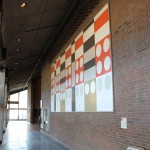

Jacques de Tonnancour hesitated between a career in science and the fine arts. He was not satisfied with the time he spent at the École des beaux-arts de Montréal. He furiously denounced academia and left after two years. Nonetheless, he continued to paint. He held his first solo exhibit in 1942 at the Dominion gallery in Montreal. After traveling to Brasil thanks to a government bursary, he ws hired a teacher at the École des beaux-arts de Montréal in 1948. During the same year year, he co-wrote Prisme d’yeux with Alfred Pellan, a manifesto that unified their opposition to the definition of avant-gardism in painting, arguing that it is too narrow. He was a resident artist at the UQAM in 1969, where he would teach until 1982. He then abandoned his artistic production to reinvigorate an old passion: collecting and photographing insects,
As he terrifyingly witnesses how Picasso becomes bound to his art, de Tonnancour painted very little from 1950 to 1955. He then returned to art by painting Laurentian landscapes. He can create many chromatic and formal variations with the use of a roller squeegee. His paintings would then get purer and purer. The painted backgrounds are then ready to host collages, accidents, symbolic allusions and geometric shapes.
Among his many distinctions, he earned a bursary from the Canadian Council for Arts and received the first prize at the Winnipeg show in 1958. In 1966, the Vancouver Art Gallery presented a retrospective exhibit of his work. De Tonnancour was named officer of the Order of Canada in 1979 and a member of the Order of Quebec in 1992.
De Tonnancour also created several pieces integrated to architecture. He painted the Université de Montréal campus in 1968 and created a part-painting par cut-up tryptich for the Dow planetarium in 1966.

Artwork description
This monumental mural was originally installed in the Jean-Brillant pavilion’s cafeteria, located on 3200 Jean-Brillant street. It was moved here during renovations.
The artist used Formica, in industrial material created in the 1950s, for artistic pruposes. He was fascinated by this beautiful surface with very intense colors. The colors – orange, brown, green, gray and white – were inspired by the colors of the cafeteria for which the piece was created. Its repetitive composition took the columns that interrupted the perception of the wall into account. Thus, the viewer, seeing only a part of the piece, could picture the rest in his head. Finally, the repetition of shapes, particularly the circles, adds rhythm to the piece. The murals made from Formica belong to the hard-edge style by the use of solid colors, with neatly defined contours and without any chromatic transitions, and by their geometrical rigor and formal economy.
Originally hung on the Jean-Brillant pavilion’s cafeteria wall, this mural is part of a series of five pieces ordered when building this pavilion as well as the Maximilien-Caron and Lionel-Groulx pavilions. Architects Beauvais and Lusignan chose Jacques de Tonnancour to provide ”artistic decorations”, as written in the contract. In his conversations with Pierre Bourgie, the artist explains that he found his rare experiences with art integrated to architecture to be enriching.

